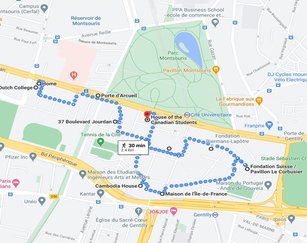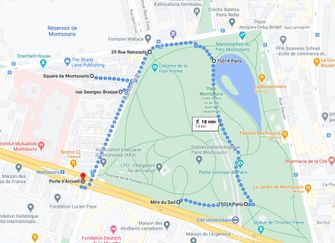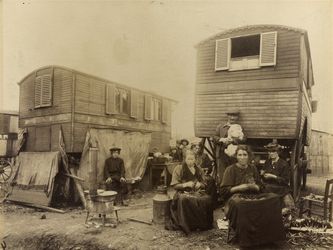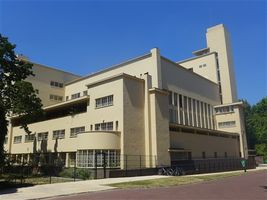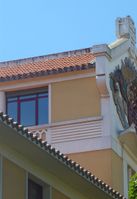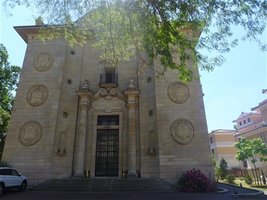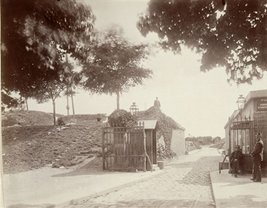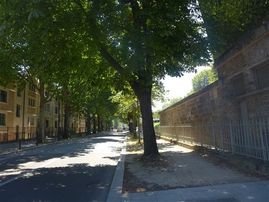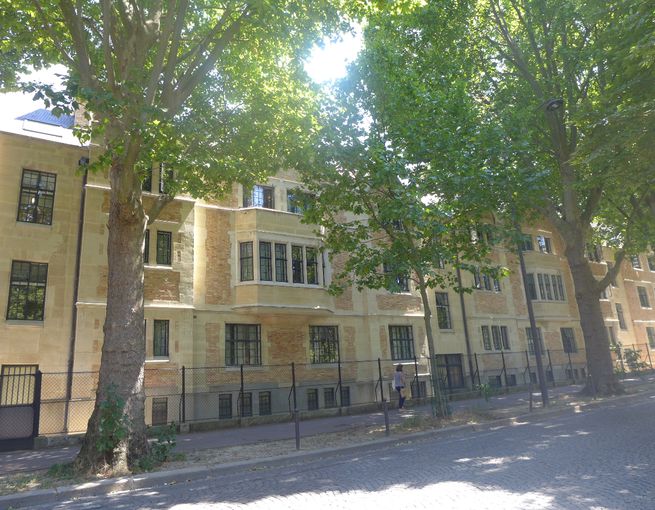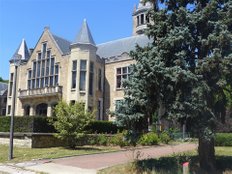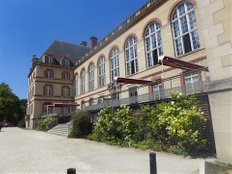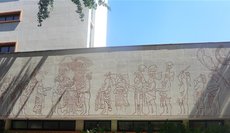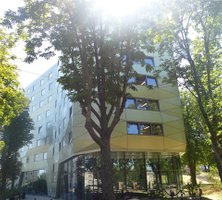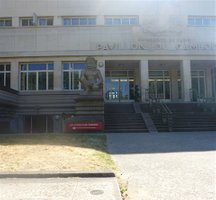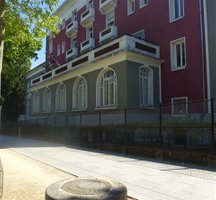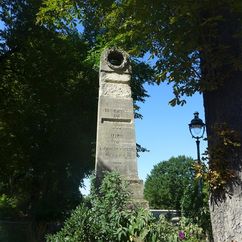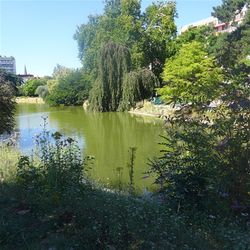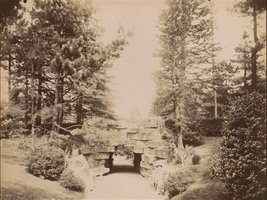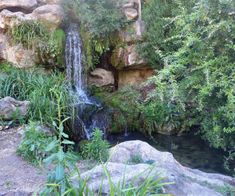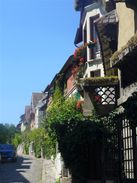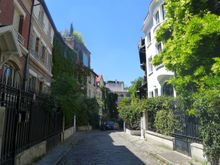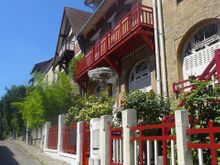Hora fugit - Un peu de Paris
Paris Meridian - Cité Universitaire and Montsouris Park
The Paris Meridian line goes through the Cité Universitaire between the student houses of Cambodia and Canada and continues through Montsouris Park. We will however take the time to discover more of the Cité Universitaire before reaching the Cambodia House.
I would also suggest to take the opportunity being in Montsouris Park to visit the charming Montsouris neighborhood along the rue Nanséty (square de Montsouris and rue Georges Braque. Following rue Nanséty will take you back to the starting point.
Cité Universitaire
The Cité Internationale was initially created thanks to an industrialist, Emile Deutsch de la Meurthe, then head of the Jupiter oil company, which later became Shell-France. Worried by the difficulties of students' housing following the First World War, Paul Appell, mathematician and rector of the University of Paris, convinced him in founding a university residence. The first buildings inaugurated in 1925 for 350 French students, were followed by other new buildings financed by foreign foundations, according to the goal of promoting peace and exchanges.
A stroll in Cité Universitaire will make you travel abroad, even without leaving Paris. The collection of exceptional buildings in a vast park will make you sometimes think to be walking in an Anglo-Saxon campus. Many buildings were designed by renowned architects. The 84 acre (34 hectares) park was designed by a landscaper gardener: Forestier, who also redesigned the Parc de Bagatelle.
When walking in this lush park, I had a dream that the gray ring road (périphérique) around Paris could have been covered or at least bordered by a long green belt. Both Cité Universitaire and the périphérique road are located on the site of the 1840 military fortifications for Paris.
When I was listening my great-grandmother talking about the fortifications and the slums area known as the « zone », I could hardly figure out what it was. Indeed, difficult for a child to imagine the military walls decided by the Prime Minister Thiers. A very long wall, running around Paris, along the current boulevard des Maréchaux. A very wide wall, about 400 meters, protected by 95 military bastions forts. In front of this long wide wall of stone was a ditch bounded by a counterscarp and an open grassland where all construction was prohibited. As shown by many famous photos by Atget, this grass area was progressively occupied by poor people living in huts and trailers.
After the First World War, the fortifications were gradually demolished between 1919 and 1929. Low-rent buildings and stadiums were built on the vacant land. And then later, between 1958 and 1973, the périphérique road was built, creating a clear and dull separation between Paris and its suburbs.
Fortifications
Atget - 1913
Musée Carnavalet
The Cité Universitaire has been in constant evolution and today some 12,000 students and researchers from more than 140 nationalities are residents of the 43 houses with different architectural styles.
A stroll in the park, which is open to the public offers together a combined tour around the world in eighty minutes and a visit to an open-air architecture exhibition.
Let's start at n° 61 boulevard Jourdan.
You cannot miss the modern, ultra geometric and refined Dutch College, designed in 1938 by the Dutch architect Willem Marinus Dudok. My special thoughts to my friends living in the charming town of Hilversum, where lived this prominent architect of the Dutch school, best known for the Hilversum Town Hall.
Opposite to the Dutch College, the South East Asia Student House, inaugurated in 1930, clearly of Indochinese inspiration.
Then, quite in a Spanish colonial style, the elegant Rosa Abreu de Grancher foundation, opened in 1933 to house Cuban students.
The Dutch College
The South East Asia Student House
The Rosa Abreu de Grancher foundation
On top of preserving its rich heritage, the Cité Internationale is also expanding with the creation of new buildings in order to sustain the demand. For instance, we can see from the Périphérique ring road the new house of Tunisia and its large metallic letters enveloping the modern building.
Let's now exit into the avenue Jourdan. We cross the avenue David-Weill, with has kept some minor elements of the fortifications photographed by Atget in 1899. From there we can also have a glimpse on the Emile Deutsch de la Meurthe Foundation, evoking an English college. This was the very first building on the former site of the fortifications.
Porte d’Arcueil – Fortifications
Boulevard Jourdan
Atget – 1899
(Musée Carnavalet)
Porte d’Arcueil
Avenue David-Weill - View from boulevard Jourdan
Les maisons de la fondation Emile Deutsch de la Meurthe édifiées à l’emplacement de l’enceinte ont incontestablement une allure de collège anglais.
Maisons fondation Emile Deutsch de la Meurthe Cité Universitaire
le long de l’avenue David-Weill
Let's go back into the Cité Universitaire, at n°37 Boulevard Jourdan. The six pavilions of the Emile Deutsch de la Meurthe Foundation with names of French scientists: Poincaré, Appell, Pierre and Marie Curie, Pasteur, ... are grouped around a nice garden.
Are we still in Paris? or in Oxford?
Let’s follow the large tree lined alley leading us to the impressive International House. Facing the vast central lawn, it looks like a small replica of the Fontainebleau castle, it was financed by John Rockefeller Jr. This is where the central library is located. It offers a collection of 50 000 books and a large collection of databases. In an other life, I wish to be a student at the Cité!
Let’s continue walking along the long facade of the International House. We now arrive at the back of the Mexico house with its Mayan-inspired fresco.
Then, the red brick Franco-British College, with its pointed roofs and round bow-windows.
Then, a little further, the Switzerland Foundation, designed by Le Corbusier and Pierre Jeanneret in the early 1930s.
Let's now go toward the ring road. On our way to the Cambodia house, we can see the new Ile de France house. This building is the first 100% solar-powered positive energy collective housing building with an inter-seasonal thermal storage system of this size realized in France. Innovative and with a pleasant design!
Of course, when I arrived in view of the House of Cambodia, I immediately started to look for my first Arago medaillon ! Easy… just in the axis of the granite monkey statue at the left of the entrance.
Let's now exit the Cité Universitaire. On Boulevard Jourdan, just in front of the Canadian Student house, on the axis of the Meridian Line, we can notice an other type of medallion: the Méridienne Verte (the Green Meridian). Green, since the meridian line is marked by trees all across France, between Dunkirk and the Pyrenees.
Parc Montsouris
Let's cross Boulevard Jourdan to enter into Montsouris park. Through the gates, we can have a sight on the Mire du Sud (South obelisk) originally placed in the gardens of the Observatory in 1806 marking the Meridian line.
This park has many similarities with the Buttes-Chaumont park. It was created by Alphand, also known as the "Haussmann's gardener", who also designed the Buttes-Chaumont. It was also created on the site of former quarries. However, it is much less scenic and the hills are less steep.
I enjoyed much this park when I was living on rue de Tolbiac. I used to run there on Sunday morning, going around the lake several times before coming back via rue Bobillot.
Let's follow on the right the allée de la Tunisie (alley of Tunisia). This name recalls the reduced size copy of the Bardo palace, formerly residence of the Beys of Tunis. This structure, initially made for the Universal exhibition of 1867, was dismantled and rebuilt on the high hill of the park. Very much deteriorated over the years, it was finally destroyed by a fire in 1991.
We are passing now over the RER B line, formerly the 1846 Sceaux railway line. Let’s take the path on the left, meandering towards the lake. It is said that the lake would have emptied the day of the inauguration of the park in 1869, a tragedy for the engineer who would have committed suicide.
True or false, this is not the only story …
There are also several stories around the name of Montsouris, which sounds in French the Mouse Mountain … Let’s tell this one which goes back far to the time of Charlemagne at the beginning of the 9th century. A story says that Ysore, a terrible Saracen giant, would have fallen not far from here, killed by William of Orange. This Ysoré, Isoré, Issoire, (per different spellings of the name) would have been buried not far from here. The place where Issoire was buried became known as the Tomb of Issoire (rue de la Tombe Issoire).
Ysoré, Ysori, Mont Ysori ... If the small Mount Ysori did not give birth to a mouse … at least a corruption of the name Mont Ysori would have given birth to the name of Montsouris…
Other stories would tell you that the name of the park would derive from the cute name of a mill: Moque Souris (Mock Mouse) … This mill was along the Bievre river … river said to be inhabited by many rodents…
Like the Buttes Chaumont park, Montsouris has a lake, small grotto, fake rocks, a (very small waterfall), and rustic railings imitating wood ...
Parc Montsouris
Atget – 1913/1914
(Musée Carnavalet)
Square de Montsouris - Rue Georges Braque
At the end of the lake, let's take the path on our left towards the Colonne de la Paix Armée (Column of Armed Peace) to exit from the park at the corner of avenue Reille and rue Nansouty.
Like the Buttes Chaumont with the quaint Mouzaïa neighborhood, Montsouris has a small charming neighborhood with the square of Montsouris, at n°8, rue Nansouty and the rue Georges Braque where the painter had his studio. In his detective novel, « the Rats of Montsouris » Léo Malet made a description of it: Modern houses with large bay windows. One floor villas hidden behind lush greenery. All comfy, quiet, nice houses for artists or just for people with lots of dough. »
At the end of rue Nansouty, we will reach our starting point on Boulevard Jourdan.
Texte / Photos : Martine Combes
Contact / newsletter:
